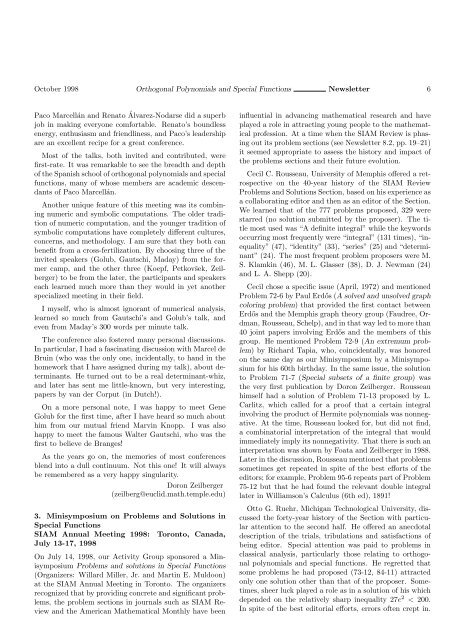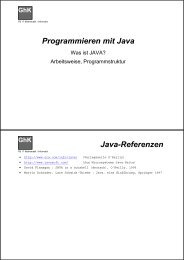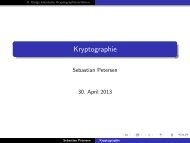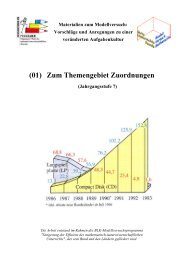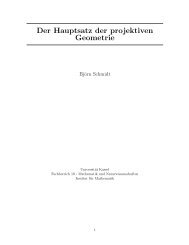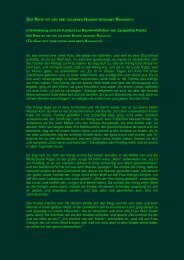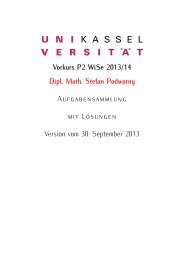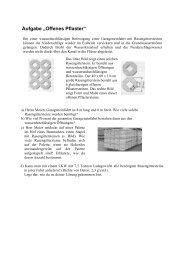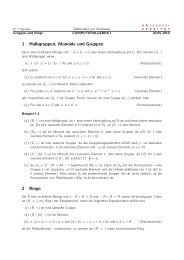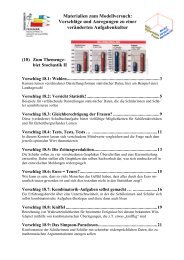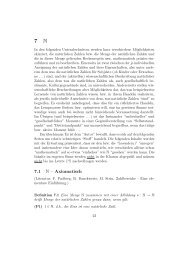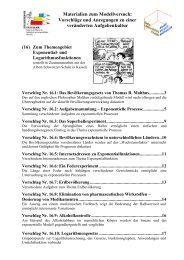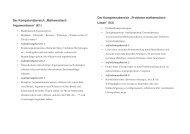Orthogonal Polynomials and Special Functions
Orthogonal Polynomials and Special Functions
Orthogonal Polynomials and Special Functions
You also want an ePaper? Increase the reach of your titles
YUMPU automatically turns print PDFs into web optimized ePapers that Google loves.
October 1998 <strong>Orthogonal</strong> <strong>Polynomials</strong> <strong>and</strong> <strong>Special</strong> <strong>Functions</strong> Newsletter 6<br />
Paco Marcellán <strong>and</strong> Renato Álvarez-Nodarse did a superb<br />
job in making everyone comfortable. Renato’s boundless<br />
energy, enthusiasm <strong>and</strong> friendliness, <strong>and</strong> Paco’s leadership<br />
are an excellent recipe for a great conference.<br />
Most of the talks, both invited <strong>and</strong> contributed, were<br />
first-rate. It was remarkable to see the breadth <strong>and</strong> depth<br />
of the Spanish school of orthogonal polynomials <strong>and</strong> special<br />
functions, many of whose members are academic descendants<br />
of Paco Marcellán.<br />
Another unique feature of this meeting was its combining<br />
numeric <strong>and</strong> symbolic computations. The older tradition<br />
of numeric computation, <strong>and</strong> the younger tradition of<br />
symbolic computations have completely different cultures,<br />
concerns, <strong>and</strong> methodology. I am sure that they both can<br />
benefit from a cross-fertilization. By choosing three of the<br />
invited speakers (Golub, Gautschi, Maday) from the former<br />
camp, <strong>and</strong> the other three (Koepf, Petkovˇsek, Zeilberger)<br />
to be from the later, the participants <strong>and</strong> speakers<br />
each learned much more than they would in yet another<br />
specialized meeting in their field.<br />
I myself, who is almost ignorant of numerical analysis,<br />
learned so much from Gautschi’s <strong>and</strong> Golub’s talk, <strong>and</strong><br />
even from Maday’s 300 words per minute talk.<br />
The conference also fostered many personal discussions.<br />
In particular, I had a fascinating discussion with Marcel de<br />
Bruin (who was the only one, incidentally, to h<strong>and</strong> in the<br />
homework that I have assigned during my talk), about determinants.<br />
He turned out to be a real determinant-whiz,<br />
<strong>and</strong> later has sent me little-known, but very interesting,<br />
papers by van der Corput (in Dutch!).<br />
On a more personal note, I was happy to meet Gene<br />
Golub for the first time, after I have heard so much about<br />
him from our mutual friend Marvin Knopp. I was also<br />
happy to meet the famous Walter Gautschi, who was the<br />
first to believe de Branges!<br />
As the years go on, the memories of most conferences<br />
blend into a dull continuum. Not this one! It will always<br />
be remembered as a very happy singularity.<br />
Doron Zeilberger<br />
(zeilberg@euclid.math.temple.edu)<br />
3. Minisymposium on Problems <strong>and</strong> Solutions in<br />
<strong>Special</strong> <strong>Functions</strong><br />
SIAM Annual Meeting 1998: Toronto, Canada,<br />
July 13-17, 1998<br />
On July 14, 1998, our Activity Group sponsored a Minisymposium<br />
Problems <strong>and</strong> solutions in <strong>Special</strong> <strong>Functions</strong><br />
(Organizers: Willard Miller, Jr. <strong>and</strong> Martin E. Muldoon)<br />
at the SIAM Annual Meeting in Toronto. The organizers<br />
recognized that by providing concrete <strong>and</strong> significant problems,<br />
the problem sections in journals such as SIAM Review<br />
<strong>and</strong> the American Mathematical Monthly have been<br />
influential in advancing mathematical research <strong>and</strong> have<br />
played a role in attracting young people to the mathematical<br />
profession. At a time when the SIAM Review is phasing<br />
out its problem sections (see Newsletter 8.2, pp. 19–21)<br />
it seemed appropriate to assess the history <strong>and</strong> impact of<br />
the problems sections <strong>and</strong> their future evolution.<br />
Cecil C. Rousseau, University of Memphis offered a retrospective<br />
on the 40-year history of the SIAM Review<br />
Problems <strong>and</strong> Solutions Section, based on his experience as<br />
a collaborating editor <strong>and</strong> then as an editor of the Section.<br />
We learned that of the 777 problems proposed, 329 were<br />
starred (no solution submitted by the proposer). The title<br />
most used was “A definite integral” while the keywords<br />
occurring most frequently were “integral” (131 times), “inequality”<br />
(47), “identity” (33), “series” (25) <strong>and</strong> “determinant”<br />
(24). The most frequent problem proposers were M.<br />
S. Klamkin (46), M. L. Glasser (38), D. J. Newman (24)<br />
<strong>and</strong> L. A. Shepp (20).<br />
Cecil chose a specific issue (April, 1972) <strong>and</strong> mentioned<br />
Problem 72-6 by Paul Erdős (A solved <strong>and</strong> unsolved graph<br />
coloring problem) that provided the first contact between<br />
Erdős <strong>and</strong> the Memphis graph theory group (Faudree, Ordman,<br />
Rousseau, Schelp), <strong>and</strong> in that way led to more than<br />
40 joint papers involving Erdős <strong>and</strong> the members of this<br />
group. He mentioned Problem 72-9 (An extremum problem)<br />
by Richard Tapia, who, coincidentally, was honored<br />
on the same day as our Minisymposium by a Minisymposium<br />
for his 60th birthday. In the same issue, the solution<br />
to Problem 71-7 (<strong>Special</strong> subsets of a finite group) was<br />
the very first publication by Doron Zeilberger. Rousseau<br />
himself had a solution of Problem 71-13 proposed by L.<br />
Carlitz, which called for a proof that a certain integral<br />
involving the product of Hermite polynomials was nonnegative.<br />
At the time, Rousseau looked for, but did not find,<br />
a combinatorial interpretation of the integral that would<br />
immediately imply its nonnegativity. That there is such an<br />
interpretation was shown by Foata <strong>and</strong> Zeilberger in 1988.<br />
Later in the discussion, Rousseau mentioned that problems<br />
sometimes get repeated in spite of the best efforts of the<br />
editors; for example, Problem 95-6 repeats part of Problem<br />
75-12 but that he had found the relevant double integral<br />
later in Williamson’s Calculus (6th ed), 1891!<br />
Otto G. Ruehr, Michigan Technological University, discussed<br />
the forty-year history of the Section with particular<br />
attention to the second half. He offered an anecdotal<br />
description of the trials, tribulations <strong>and</strong> satisfactions of<br />
being editor. <strong>Special</strong> attention was paid to problems in<br />
classical analysis, particularly those relating to orthogonal<br />
polynomials <strong>and</strong> special functions. He regretted that<br />
some problems he had proposed (73-12, 84-11) attracted<br />
only one solution other than that of the proposer. Sometimes,<br />
sheer luck played a role as in a solution of his which<br />
depended on the relatively sharp inequality 27e 2 < 200.<br />
In spite of the best editorial efforts, errors often crept in.


